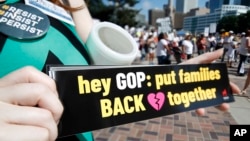A judge said Tuesday it appeared the Trump administration could identify potentially thousands of children who were separated from their families at the border in much less time than the one to two years officials want to complete the work, though he was reluctant to impose a deadline.
U.S. District Judge Dana Sabraw asked lawyers for the administration and for the American Civil Liberties Union to reach an agreement before an April 24 hearing that will include Jonathan White, a U.S. Health and Human Services Department official who led a previous effort that reunited more than 2,700 children with their families.
The judge frequently praises White, saying Tuesday he had “great credibility” and was nonpartisan.
Two years, 47,000 cases
The Justice Department has said it will take as long as two years to review about 47,000 cases involving unaccompanied children who were taken into U.S. government custody between July 1, 2017, and June 25, 2018, the day before Sabraw halted the general practice of splitting families and ordered that children in custody be reunited with their parents.
The ACLU said in a court filing Monday that the government’s timetable showed “callous disregard” for families and asked the judge to order that all separated families be identified in three months.
Sabraw said he was unprepared to set deadlines and that the two sides should quickly develop a joint plan. If those efforts fail, he said he would go the “old-fashioned way” of entertaining competing arguments and deciding himself, calling that route “a great disservice.”
Last year, the judge set tight deadlines to reunify more than 2,700 children, which was largely accomplished through frequent and sometimes contentious hearings in his San Diego courtroom.
'Very significant issue'
In January, the Health and Human Services Department’s internal watchdog reported that thousands more children may have been separated from their families since summer 2017. The department’s inspector general said the precise number was unknown.
Sabraw ruled last month that he could hold the government accountable for those separated before his June order and asked the government to submit a proposal.
“This is a very significant issue, obviously,” Sabraw said Tuesday. “It is as important as the initial parent reunification, and the same care and attention and energy needs to be paid to this second reunification.”
White said in an affidavit earlier this month that the sheer volume of 47,000 cases makes the job different than identifying who among 12,000 children in custody at the time of the judge’s June order had been separated from their parents.
Low-hanging fruit
The ACLU said the government likely has a list of families that were separated after April 2018 or that it could produce one within days.
Sabraw warmed to the idea of dealing with those families first instead of waiting up to 12 weeks to design a statistical model to flag those children most likely to have been separated, as the administration has proposed.
“It just seems to me there’s a lot of low-hanging fruit here in the April, May, June timeframe ... and the process can start right away,” the judge said.










